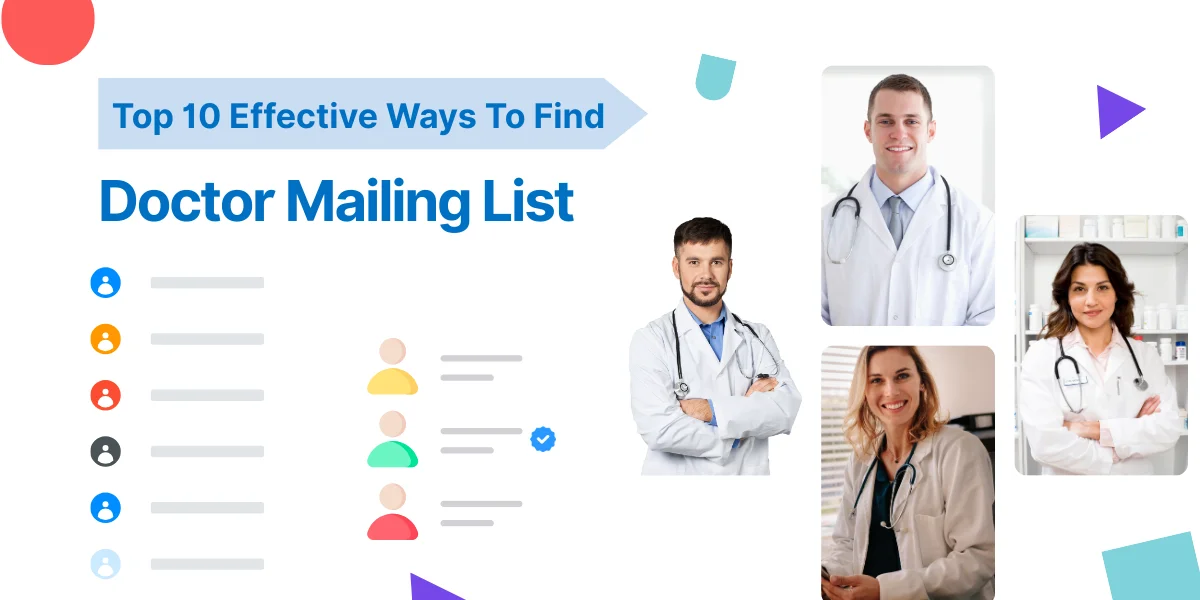How to Reach the Right Decision Makers?
Identifying the Key Decision Makers for Your Product or Services

Table of Contents
- Introduction : How to Reach Key Decision Makers?
- Understanding Who the Decision Makers Are
- Researching Your Target Audience
- Creating an Ideal Buyer Persona
- Choosing the Right Channels to Reach Decision Makers
- Crafting Personalized Messages That Convert
- Leveraging Data and Analytics for Targeted Outreach
- Building Trust and Authority
- Overcoming Gatekeepers and Common Obstacles
- Nurturing Relationships for Long-Term Engagement
- Tools and Resources for Reaching Decision Makers
- Conclusion & Key Takeaways
1. How to Reach Key Decision Makers?
Reaching the right decision makers is crucial for consistent business growth. Whether you’re a sales professional, marketer, entrepreneur, or job seeker, access to a verified business decision makers email list can open doors to faster deals and valuable partnerships. Connecting with professionals who hold purchasing power can turn outreach into real conversions.
Many companies waste time targeting outdated or unverified contacts. That’s why a reliable B2B decision makers database is essential—it ensures your messages reach the right inboxes, shortens sales cycles, and boosts ROI.
Decision makers are busy and selective, so success requires more than generic messages. Personalization, credibility, and persistence, supported by high-quality data like targeted email lists or industry-specific B2B databases, make all the difference.
This guide will show you how to identify, connect with, and build relationships with decision makers using verified contact lists, helping you reach the people who truly matter.
2. Understanding Who the Decision Makers Are
Before reaching decision makers, it’s essential to know exactly who they are. In any organization, decision-making authority varies depending on company size, the type of product or service, and the complexity of the purchase. Identifying the right roles ensures your outreach is targeted and effective.
Key Roles to Target:
- C-Suite Executives: CEOs, CFOs, CIOs, and COOs drive high-level strategic decisions. They are ideal targets for enterprise solutions but require highly personalized, value-driven messaging.
- Vice Presidents and Directors: These mid-level leaders evaluate solutions and often recommend approvals. They bridge strategy and execution, making them influential in decision-making.
- Managers and Team Leads: While not always the final approvers, these individuals shape decisions by providing operational insights and feedback.
- Procurement Officers: For products or services requiring formal purchasing processes, procurement professionals act as critical gatekeepers.
Understanding the hierarchy and influence patterns within your target organization allows you to craft precise outreach strategies, ensuring your efforts reach the people who truly matter.
3. Researching Your Target Audience
Successfully reaching decision makers starts with thorough research. Generic outreach rarely works—you need detailed insights into each individual’s role, priorities, and challenges.
Leverage Online Databases and Professional Networks
Platforms like LinkedIn Sales Navigator, Crunchbase, and AverickMedia allow you to find professionals based on role, industry, company size, and location. LinkedIn, in particular, offers access to career histories, skills, and mutual connections, enabling highly personalized engagement.
Utilize CRM and Sales Intelligence Tools
Customer Relationship Management (CRM) platforms such as HubSpot, Salesforce, and Pipedrive help track interactions, manage leads, and maintain up-to-date information on decision makers. Combining CRMs with sales intelligence tools ensures your team has access to verified, high-quality contact data at all times.
Understand Their Pain Points and Goals
Decision makers respond to value, not generic pitches. By understanding their business challenges, industry trends, and specific objectives, you can position your product or service as a meaningful solution rather than just another sales message.
4. Creating an Ideal Buyer Persona
Buyer personas are semi-fictional representations of your ideal customers. They help you understand your audience’s motivations, preferred communication channels, and decision-making process.
Steps to Develop Effective Personas
- Collect Demographic Data: Age, gender, location, and role within the organization.
- Understand Job Responsibilities: Know their key responsibilities, KPIs, and reporting structure.
- Identify Pain Points: What challenges are they facing that your product or service can solve?
- Determine Decision-Making Power: Are they the final approver, influencer, or evaluator?
- Segment by Industry and Role: Tailor your messaging to each segment’s unique needs.
Well-crafted buyer personas allow your outreach campaigns to resonate, increasing the likelihood of engagement and conversion.
5. Choosing the Right Channels to Reach Decision Makers
Decision makers are busy professionals inundated with messages daily. Reaching them effectively requires selecting the right channels and delivering value that captures their attention.
Email Marketing
Email remains one of the most reliable ways to engage decision makers. To make your outreach stand out:
- Craft personalized subject lines using the recipient’s name, company, or role.
- Lead with a compelling value proposition that addresses their specific needs.
- Keep messages concise, clear, and free of jargon.
- End with a strong, actionable call-to-action (CTA).
LinkedIn Outreach
LinkedIn is the preferred platform for professional networking. Effective LinkedIn strategies include:
- Sending tailored connection requests that reference mutual contacts or shared interests.
- Engaging with their posts and sharing relevant insights to establish credibility.
- Following up with thoughtful messages that provide value, rather than push sales.
Phone Calls and Webinars
For high-value prospects, personalized phone calls or webinar invitations can be highly impactful. Well-prepared, concise calls demonstrate respect for their time and signal a genuine interest in addressing their challenges.
Multi-Channel Integration
The most successful outreach combines email, social media, calls, and content engagement. Coordinated campaigns build trust, increase brand familiarity, and significantly improve response rates.
6. Crafting Personalized Messages That Convert
Generic sales pitches rarely capture the attention of decision makers. To break through the noise, personalization is not optional—it’s essential. Tailored communication shows that you understand their challenges and are offering a solution that truly matters.
Proven Personalization Techniques
- Highlight recent company achievements, initiatives, or challenges.
- Align your solution directly with their goals, pain points, or strategic priorities.
- Mirror their preferred communication style—formal, conversational, or data-driven.
- Emphasize tangible outcomes such as cost savings, efficiency gains, or revenue growth.
Structuring Messages for Maximum Impact
- Hook: Grab attention within the first sentence with relevance or insight.
- Value Proposition: Clearly show how your solution addresses their specific needs.
- Social Proof: Include credible evidence like case studies, testimonials, or industry statistics.
- Call-to-Action (CTA): Guide them to the next step—whether it’s a call, demo, or consultation.
Studies show that highly personalized outreach can increase response rates by over 50%, demonstrating that investing time in crafting tailored messages pays off significantly.
7. Leveraging Data and Analytics for Targeted Outreach
Data-driven outreach allows your team to focus on high-potential leads and optimize messaging.
Key Metrics to Track
- Email open and click-through rates
- Response and conversion rates
- Social engagement metrics
- Lead scoring based on behavior and demographics
Predictive Analytics
Advanced analytics tools can forecast which leads are most likely to engage based on historical behavior, allowing your sales team to prioritize outreach efficiently.
8. Building Trust and Authority
Decision makers are more likely to engage with individuals and brands they trust. Building credibility requires consistent, value-driven communication.
Strategies to Establish Credibility
- Publish insightful content, such as whitepapers, industry reports, and case studies.
- Share success stories demonstrating measurable results.
- Engage on professional forums and social media to provide thought leadership.
- Avoid aggressive sales tactics that can damage trust.
Trust is cumulative. Persistent, relevant engagement positions your brand as a reliable partner rather than just a vendor.
9. Overcoming Gatekeepers and Common Obstacles
Techniques to Get Past Gatekeepers
- Be transparent about your purpose while emphasizing value.
- Use referrals or mutual connections to gain introductions.
- Time your outreach strategically, avoiding peak hours.
Handling Objections
- Present evidence-backed benefits
- Offer flexible solutions tailored to their needs
- Follow up with helpful resources rather than pressure
Persistence paired with professionalism often opens doors that initial attempts cannot.
10. Nurturing Relationships for Long-Term Engagement
Connecting with decision makers is not a one-time effort; it requires relationship-building over time.
Effective Nurturing Tactics
- Send periodic insights, such as industry news or reports.
- Celebrate their achievements or company milestones.
- Provide exclusive access to events, demos, or content.
- Use CRM tools to track engagement history and follow-ups.
Strong relationships lead to repeat business, referrals, and long-term partnerships, making nurturing just as important as initial outreach.
11. Tools and Resources for Reaching Decision Makers
Sales Intelligence Tools
Platforms like LinkedIn Sales Navigator, ZoomInfo, and Clearbit provide verified contact information, company insights, and engagement analytics.
CRM Software
CRMs such as Salesforce, HubSpot, and Pipedrive streamline lead management, track communication, and automate follow-ups, ensuring no opportunity is missed.
Email Automation & Personalization Platforms
Tools like Mailshake, Outreach, and Lemlist enable personalized, automated campaigns while tracking performance metrics to optimize outreach strategies.
12. Conclusion & Key Takeaways
Reaching the right b2b decision makers is both an art and a science. Success depends on meticulous research, personalized messaging, strategic multi-channel outreach, and consistent relationship-building. By understanding their priorities, crafting relevant communications, and leveraging the right tools, businesses can improve engagement, shorten sales cycles, and build meaningful partnerships.
Key Takeaways:
- Identify decision makers accurately within the organization.
- Conduct thorough research to understand their needs and goals.
- Create detailed buyer personas to guide personalized outreach.
- Use multiple channels—email, LinkedIn, phone calls, webinars—for maximum impact.
- Personalize every message to demonstrate value and credibility.
- Leverage data, analytics, and sales intelligence for targeted campaigns.
- Build trust through thought leadership and social proof.
- Overcome gatekeepers with strategic approaches and persistence.
- Nurture relationships to ensure long-term engagement and repeat business.
- Use tools and technology to streamline processes and increase efficiency.
By following these strategies, your team can successfully reach the decision makers who drive organizational choices, positioning your products or services for maximum impact and ROI.



